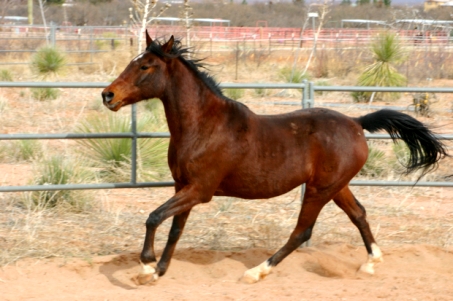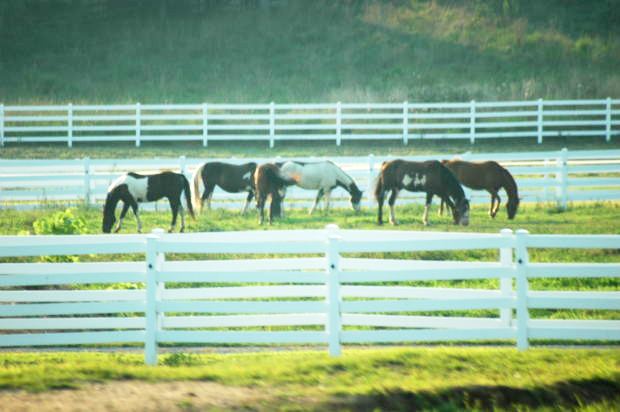In the horse world, the over-abundance of free-flying opinions is always evident. You can have two different horsemen with successful training programs and they will not see eye-to-eye on even one training technique. One topic that often sparks a good debate is training horses in a round pen.
I have heard horse people claim that a round pen makes a horse uncomfortable, there’s no place for it to rest, and its instincts are triggered to only run. Some have said that the round pen method only involves chasing the horse in circles until it is too tired to run and will accept being handled. And some folks just don’t like the round pen simply because they don’t know what to do with one. While I understand that you can successfully train a horse without a round pen, I’d like to point out some things about the usefulness, purpose, and techniques of the round pen.
First of all, let me say that round penning is not for every horse. Each horse should be viewed as an individual, and a good trainer will gauge that horse’s needs and act accordingly. A horse that is extremely calm, handles nicely, and has its groundwork down to an art will not benefit that much from a round pen, if any. Most likely, the gentle horse will stand about in calm confusion, as if thinking, “What in the world is this all about?” While there are still some things you can do with this type of horse in a round pen, most everything could be done elsewhere (arena, corral, or even an open space) and still get the same results. A scared, spooky, or untrusting horse will gain the most from experience in the round pen, and it will most likely change his mind about accepting the trainer’s presence and touch.
The main purpose of a round pen is to engage the horse’s mind to focus and respond to the trainer. The shape of the pen contributes to directing the horse’s attention inward, rather than him finding a corner to “hide out” in, or escaping the trainer’s presence by finding the side closest to his buddies and hanging his head over the rail calling to them. The methods used in round penning involve communicating with body language to gain the horse’s focus and get him to allow the trainer to work closely with him in preparation for all the training that will follow subsequently. It is most effective for a spooky horse, or one that is hard to catch or handle, and it lays a base foundation of trust and communication that will prepare the horse for riding and training later on.
The method itself can vary, as each horse responds a different way, but I’ll describe the ideal scenario. You put a horse in a round pen, and gently ask him to move out, in a circle, and move away from you. You do this with body language and maybe reinforcement such as a stick with a rustly flag or plastic bag tied to the end, or else with a lariat rope that you can swing at the horse’s heels. Basically get him to move out fast and circle the pen several times. Some horses may need more encouragement to get them to leave you and move around the pen. If the horse is “stuck” to you already, you may need to be more demanding with waving your arms, flag stick, or swinging the end of a lead rope or something to really get the horse to move away into a circle.
The horse (unless extremely gentle or docile) will look for a way out and eventually realize that the only thing to focus on is you. He will start to make changes in his expression and body language. He may slow down, his ears may flick toward you, his eye will be constantly on you. He will show signs of wanting to slow down or stop. I usually allow a horse to stop, and often they will chew or grind their teeth as a sign of acceptance or “thinking”. I would step toward the horse with gentle body language (stick/lariat down on the ground or held closely to my side) and see if he will let me approach and pet him. If not, if he turns away, I instantly change body language and MAKE him move again, maybe in the other direction this time. He will circle again, but be ready to stop sooner. Again, I want to let him rest a little and attempt to go to his head and pet him. If he turns away even slightly, I will spook him and make him move.
You want the horse to be controlled by your position, and you want to ask the horse to move in one direction for a few circles, and then step forward in front of the horse and ask him to reverse and go the opposite direction around the pen. One goal of round penning is, any time that horse turns or switches directions in the pen, he should never turn his heels/hind end at you. When you ask him to turn, you step in front of him, and he should wheel on his hind legs with his head towards the center of the pen, and reverse directions in his circle. If he turns his hind end towards you, swing your lariat or lead rope at his heels, or else spook him with the flag stick and make him circle the pen at a lope again. In other words, you are giving a clear bodily message that his action was the wrong one. This teaches a horse to watch your body language for direction, look to you for leadership, and see you as the dominant figure.
After a few times of switching directions, letting him slow down and trying to approach his head, he is going to really start thinking. He will see that the work involved in circling the pen is getting him nowhere, and he will start to think that the only way to rest or get anywhere is to let you pet him and remain turned towards you. Because any time he turns AWAY, he has to work and run again. He will learn to just stand there and allow you to pet him. You should rub him all over, letting him stand still and keeping close to him, reaching all over his back, under his belly, petting him everywhere. If he no longer moves away from your touch, you are ready to move on.
When he does this, then I consider this the beginning of the “join up”. He is starting to realize that he needs to follow you and pay attention to you. If I’m petting the horse and his attention drifts outside the pen or to another horse nearby, I will instantly step backwards away from him and slightly behind him, and take up my flag stick again. He should instantly focus on me, turn around, face me and want to be close again. If he moves away from me, he’s going to have to circle the pen a few more times. So the horse will just learn to follow you around.
You can pet him, then move back a few steps and towards his hind end, like you’re going behind him (keep a safe distance from his heels, though). He should turn and follow you. You can even turn your back and walk away, and often the horse will follow right behind you because he has “joined up” with you. You can walk all around the pen with the horse following. Any time his attention drifts or he stops following, you circle behind him and if he doesn’t turn his face to you or follow you, you do whatever spooking method you started out with to make him move out again and trot a few more circles.
And that is the basic technique of using a round pen. The horse will learn to trust you, watch you, obey you, and depend on you. A few tips concerning round pens are to be sure your pen is large enough for the horse to move out freely. A fifty foot diameter is the minimum, if you’re going to ask a horse to lope. Sixty foot is better. And I would advise to only do this exercise with a horse that is two years old and above, as that much work can stress the hocks and knees of a younger colt. You can find many online tips and ideas for building a round pen or purchase portable panels from your local farm supply store. The round pen is a very valuable tool for anyone wanting to train horses.


